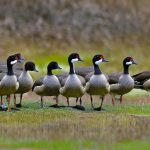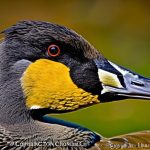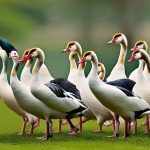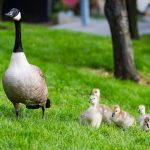Canadian geese, also known as Canada geese, are a species of waterfowl that are native to North America. These majestic birds are known for their distinctive black heads and necks, white patches on their faces, and brown bodies. They are a common sight in many parts of Canada and the United States, where they can be found in a variety of habitats, including lakes, rivers, and marshes. Canadian geese are known for their strong migratory instincts, and they can often be seen flying in V-shaped formations as they travel to and from their breeding grounds. These birds are not only beautiful to look at, but they also play a crucial role in the ecosystems in which they live, making them an important species to study and protect.
Understanding the Mating Rituals of Canadian Geese
The mating rituals of Canadian geese are a fascinating and complex process that begins in the early spring. During this time, the geese engage in elaborate courtship displays, which involve a series of calls, postures, and movements designed to attract a mate. Once a pair has formed, they will engage in a series of bonding behaviors, such as preening each other’s feathers and engaging in synchronized swimming. These rituals help to strengthen the bond between the pair and prepare them for the breeding season. Once the pair has bonded, they will begin to search for a suitable nesting site, where they will build a nest and prepare to lay their eggs.
The Intricate Nesting Habits of Canadian Geese
Canadian geese are known for their intricate nesting habits, which involve the selection of a suitable site, the construction of a nest, and the laying of eggs. The geese typically prefer to nest in areas that are near water, such as on the shores of lakes or rivers, where they can easily access food and escape from predators. The female goose will construct the nest using a combination of twigs, grass, and feathers, creating a shallow depression in which to lay her eggs. Once the nest is complete, the female will lay a clutch of eggs, which she will then incubate for several weeks until they are ready to hatch. The male goose will stand guard over the nest, keeping a lookout for potential threats and predators while the female tends to the eggs.
The Role of Pair Bonding in Canadian Geese Breeding
Pair bonding plays a crucial role in the breeding behavior of Canadian geese, as it helps to ensure the success of the breeding season. Once a pair has bonded, they will work together to select a suitable nesting site, build a nest, and care for their eggs and goslings. The bond between the pair is strengthened through a series of behaviors, such as preening, synchronized swimming, and vocalizations, which help to reinforce their commitment to each other. This strong bond is essential for the successful rearing of their young, as it allows the pair to work together to protect their nest and offspring from potential threats.
The Importance of Nest Site Selection for Canadian Geese
The selection of a suitable nest site is crucial for the breeding success of Canadian geese, as it can have a significant impact on the survival of their offspring. The geese typically prefer to nest in areas that are near water, as this provides them with easy access to food and a safe place to escape from predators. They also look for sites that are well-hidden and provide good visibility, allowing them to keep an eye out for potential threats. Once a suitable site has been found, the female will construct a nest using a combination of twigs, grass, and feathers, creating a shallow depression in which to lay her eggs. The selection of a suitable nest site is a critical step in the breeding process, as it can have a significant impact on the survival of the eggs and goslings.
The Fascinating Incubation Period of Canadian Geese
Once the female Canadian goose has laid her clutch of eggs, she will begin the incubation process, during which she will sit on the eggs to keep them warm and protected. The incubation period typically lasts for around 25-30 days, during which time the female will rarely leave the nest, relying on the male to bring her food and keep watch over the nest. As the eggs near hatching, the female will become increasingly protective of the nest, using her body to shield the eggs from potential threats and predators. Once the eggs have hatched, the female will continue to care for the goslings, leading them to water and teaching them how to forage for food.
The Challenges of Raising Goslings for Canadian Geese
Raising goslings can be a challenging task for Canadian geese, as they must protect their offspring from a variety of threats and predators. Once the goslings have hatched, the parents will lead them to water, where they will teach them how to swim and forage for food. The goslings are vulnerable to a variety of predators, including foxes, raccoons, and birds of prey, so the parents must remain vigilant and ready to defend their young at all times. The goslings will remain with their parents for several months, during which time they will learn essential survival skills and prepare for their first migration.
The Impact of Human Interaction on Canadian Geese Breeding
Human interaction can have a significant impact on the breeding behavior of Canadian geese, as it can disrupt their natural behaviors and habitat. Development and urbanization can lead to the destruction of important nesting sites, forcing the geese to seek out alternative locations that may be less suitable for breeding. Human activities, such as boating and fishing, can also disturb nesting geese, causing them to abandon their nests and eggs. In some cases, human feeding of geese can lead to overpopulation and the spread of disease, which can have a negative impact on the health and breeding success of the birds. It is essential for humans to be mindful of their interactions with Canadian geese and to take steps to protect their breeding habitats.
The Migration Patterns of Canadian Geese and Their Breeding Grounds
Canadian geese are known for their strong migratory instincts, and they can often be seen flying in V-shaped formations as they travel to and from their breeding grounds. The geese typically breed in the northern parts of North America, such as Canada and Alaska, where they can find suitable nesting sites and abundant food sources. Once the breeding season is over, the geese will begin their migration south, traveling to warmer climates where they can find food and shelter during the winter months. The migration patterns of Canadian geese are a remarkable sight to behold, as thousands of birds can be seen flying in unison as they make their way to their wintering grounds.
Conservation Efforts for the Protection of Canadian Geese and Their Breeding Habitats
Conservation efforts are essential for the protection of Canadian geese and their breeding habitats, as they face a variety of threats from human activities and environmental changes. Efforts to protect and restore important nesting sites, such as wetlands and marshes, can help to ensure that the geese have suitable places to breed and raise their young. It is also important to educate the public about the importance of preserving the natural habitats of Canadian geese and to promote responsible interactions with these magnificent birds. By working together to protect the breeding habitats of Canadian geese, we can help to ensure the survival of this iconic species for generations to come.
Meet Walter, the feathered-friend fanatic of Florida! Nestled in the sunshine state, Walter struts through life with his feathered companions, clucking his way to happiness. With a coop that’s fancier than a five-star hotel, he’s the Don Juan of the chicken world. When he’s not teaching his hens to do the cha-cha, you’ll find him in a heated debate with his prized rooster, Sir Clucks-a-Lot. Walter’s poultry passion is no yolk; he’s the sunny-side-up guy you never knew you needed in your flock of friends!







